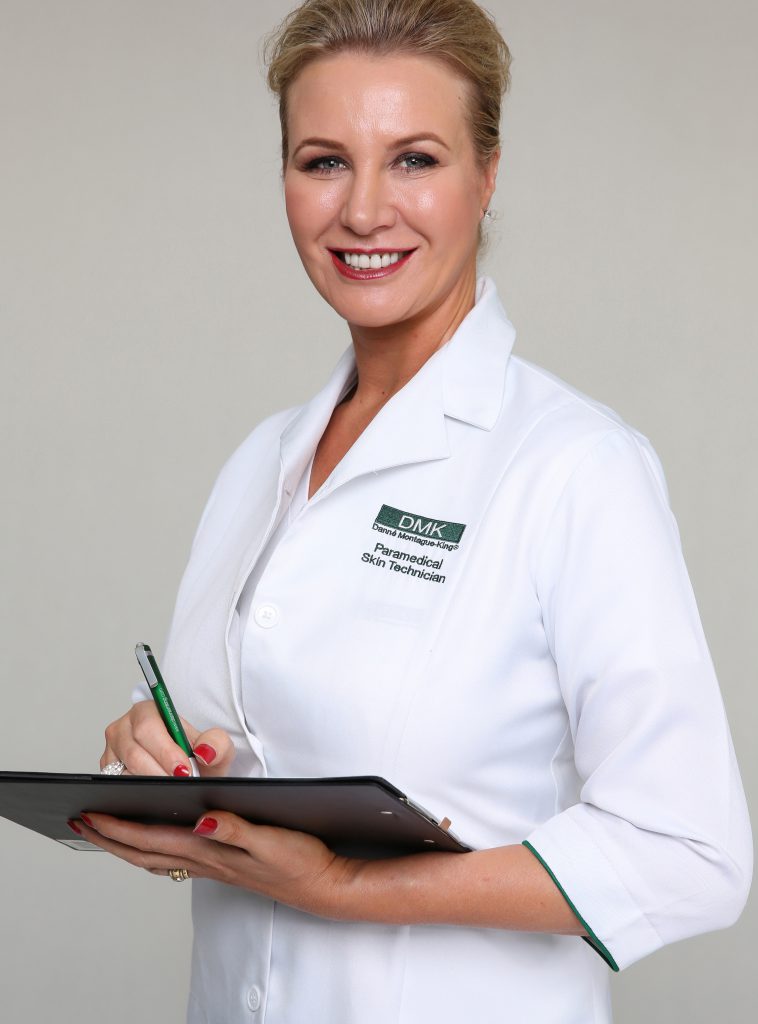As a salon professional, it’s our job and passion to help correct skin issues, but what happens when we get a case that is seems just too big to handle? We talk to Debbie Dickson, head of education research and development at DMK, about when we should refer a client onto a doctor – and how we can work alongside medical practitioners.

You have had a long career in fixing problem skin, what are some of the hardest cases to treat in your experience?
“Really deeply congested acne skin can be a challenge,” says Debbie Dickson, head of education research and development at DMK. “That’s certainly not to say that it’s not treatable, because it is. They can just take a long time to clean out all the micro comedones and regulate the skin functions. The other one that takes time is pigmentation. I would do ageing every day of the week, it is easy.”
Being diligent is fantastic but is there a point when a therapist should refer a client onto a medical practitioner?
“Yes definitely. We work in conjunction with many doctors to combine modalities, especially for injectables as this can achieve great results,” says Dickson. “We revise the skin back into a healthy balanced state and then the doctor can enhance the results with some fillers of different injectables. In this instance, I like to educate therapists and clients that there is no point in putting filler into a crappy looking skin – you will just have a crap skin that is a bit fuller. You need to revise the skin back into a healthy youthful appearance. Then have a doctor apply the filler to add volume.”
So, when it comes to Botox, good skin actually comes before a date the doctor…?
“Yes, clients don’t realise that if you don’t have good free water levels in your skin, a nice thick extra cellular matrix, and good structural integrity, your skin cells can see this filler as a food and a source of nutrients,” says Debbie. “The result is fillers won’t last as long and [your client’] will waste money.”
Do you have an example of a skin condition that was too far gone to treat in salon?
“Yes, I had a client who was actually referred to me by a Doctor. Let’s call her Lucy,” says Debbie. “Lucy has a chemical peel preformed by a doctor (not the one who referred her to me) and it got infected. So the Dr had scrapped it and she was left extremely red/fibrous scarring. Needless to say and quite understandably, Lucy was very traumatized; to the point she was so nervous about everything. We tried to strengthen her skin, but in the end, she was just so extremely nervous and scared of everything that I could not do anymore, which was sad because you get into this business to help people.”
Are there some skin conditions, which respond well to tandem treatment between a doctor and a skin therapist?
“Absolutely I am a big fan of combining modalities to enhance results,” says Dickson. “Ageing is one we do a lot in conjunction with doctors. Never be afraid of combining modalities, an integrated approach for any condition is the best.”
Are there any skin conditions/issues that a therapist should not tackle…?
“Yes. If a therapist doesn’t know what it is, then don’t touch it,” says Dickson. “Especially, if it looks like something contagious, for example impetigo. If in doubt, send those clients to the doctor to get it checked.”

What severe skin conditions have you successfully treated? How many sessions/how long ” did it take?
“I have successfully treated numerous severe acne clients,” says Dickson. “This can take around eight months to 18 months depending on their age, the condition of their skin, how well they stick to the home program, and if they do the dietary changes. I always start these clients on a 12-treatment program. However, in the case of severe acne they would probably need three of these programs.”
“In terms of ageing, we have our Pro Alpha Six Layer Peel and RP( Remodelling Procedure) peel,” says Dickson. “Therefore, to treat this condition, the turnaround time is much faster and I can generally revise ageing in 1 to 3 months.”
“For pigmentation, it depends on the type of pigmentation,” says Dickson. “The quickest way is to do the Pro Alpha Six Layer Peel. Followed by revising the last specific areas. This is achieved by alternating Enzyme Therapy with our Melanotech system – could be 8 weeks or 12 weeks. If they don’t want to have a peel, we do a more progressive skin revision program where they come weekly then every 2 weeks, then once a month, these pigmentation skin revision programs can be 12 treatments up to 24 treatments. In terms of hyperpigmentation, [the easiest method] is with the RP Peel, which can be as quick as 2 weeks!
How do you feel when you help a person with a really serious skin issue?
“I love the feeling, it is so rewarding when you can gift someone the skin that they have always wanted,” says Dickson. “It is life-changing for that person. I find it inspiring as I just want to make as many people as possible look and feel as good as they can. So, I feel as real sense of achievement. This is really why I do what I do, and why I am so passionate about sharing my knowledge and the DMK philosophy with as many passionate therapists as possible so they can achieve the same results for their clients. Our tag line is actually “Building confidence from the outside in”.”

